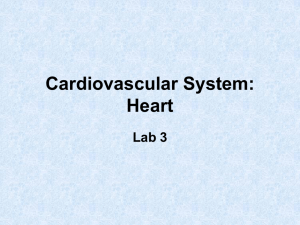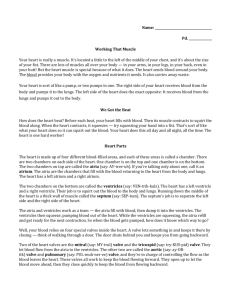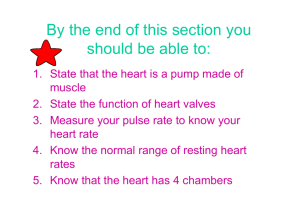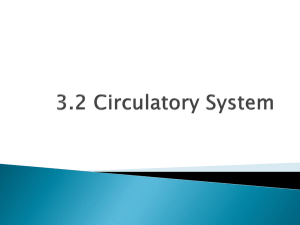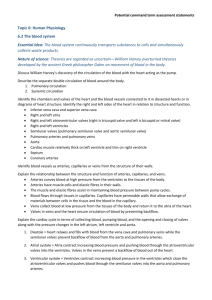The Human Heart
advertisement
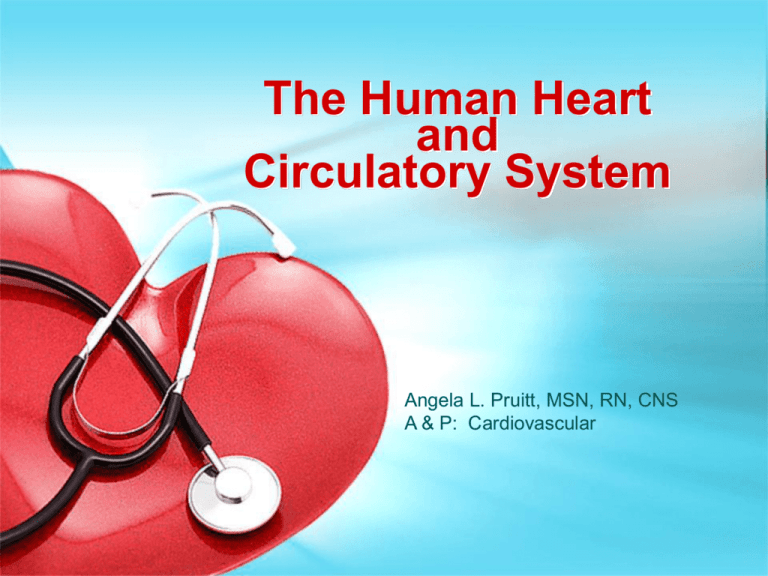
The Human Heart and Circulatory System Angela L. Pruitt, MSN, RN, CNS A & P: Cardiovascular Heart Trivia • Average human heart beats 36.5 million times/yr. • Heart weighs about 10 ounces. • Size of a fist. – Blue Whale’s heart is as big as a car! • Yawning may be due to inadequate oxygen being carried by the cardiovascular system. • German researchers- risk for heart attack is higher on Monday’s. • Women’s hearts beat faster. • Athletes resting heart rate is 35 – 40 bpm. • Human body blood vessels approx. 70,000 miles. • 7% of body weight is blood. Introduction • CV System : heart, blood vessels • Arteries, capillaries, veins • Vital for supplying O2 and nutrients to tissues; remove waste • Pulmonary Circuit – Lungs – Deoxygenated blood • Systemic Circuit – remaining – Oxygenated blood to all body cells Structure, Size & Location • Hollow, Cone shaped • Muscular organ • Two sides have separate functions • The size of your fist – About 14 cm long / 9 cm wide • SEPTUM thick section between the ventricles called the Location of Heart in Body 1. Beneath sternum in the Mediastinum • Lungs bilaterally; spine posterior 2. BASE – upper right; 2nd rib (ICS) 3. APEX – lower left; 5th rib (ICS) Anatomy of Heart Pump • Right side – lungs • Left side - body Systemic Circulation – Left side sends blood at high pressures to body Pulmonary Circulation Connected to blood vessels to carry oxygen and nutrients to body cells and remove waste products – Right side sends blood through lungs at lower pressure How Does the Heart Function? • http://video.about.com/heartdisease/How-theHeart-Functions.htm Circulation is a ONE WAY SYSTEM ARTERIES •oxygen-rich blood away from your heart. VEINS •oxygen-poor blood back to your heart. PULMONARY CIRCULATION Roles Are Switched •pulmonary artery brings oxygen-poor blood into your lungs. •pulmonary vein brings oxygen-rich blood back to your heart. How does Pulmonary & Systemic System look? Covering of Heart- Pericardium Fluid filled sac, encloses heart. Lubricate, protect, reduce friction Outer layer – tough fibrous Two inner layers • Visceral– covers heart Pericardial sac – formed by parietal and fibrous pericardium • Parietal– middle layer • Pericardial cavity – serous fluid to reduce friction What is Friction? • RUBBING OF ONE OBJECT OR SURFACE AGAINST ANOTHER: PERICARDITIS – Inflammation of the Pericardium – Due to infection- viral or bacterial – Cause adhesions( the layers stick together) - FRICTION – VERY PAINFUL • Heard- Pericardial RUB • Sounds like cellophane being rubbed Three Layers of Wall of the Heart 1. Epicardium – outer, connective tissue – Serous membrane, reduces friction – Blood & lymph capillaries; coronary arteries 2. Myocardium – middle, muscle fibers – Thickest layer – Pumps blood out of heart 3. Endocardium – inner, elastic and collagen fibers; – contain the Purkinje fibers MYOCARDIAL LAYERS HELPS THE HEART CONTRACT! Layers Four CHAMBERS of the Heart Two Atria (upstairs) Two Ventricles (downstairs) • Top, thin walls • Bottom; Larger, thicker walls • Receive blood • Receive blood from Atria returning to the heart • Contract to pump blood & pumps to ventricles to body • Low pressure • High Pressure SEPTUM – separates right & left side; never mixes blood Four CHAMBERS of the Heart TWO ATRIA Right Atrium (RA) TWO VENTRICLES Right Ventricle (RV) • Receives from superior • Blood goes only to & inferior vena cava lungs Left Atrium (LA) Left Ventricle (LV) • Smaller, thicker walls • Receives blood from pulmonary veins • Blood goes through aorta to vessels in entire body Heart Valves – One Way Blood Flow Prevents blood from backing up into the heart ATRIOVENTRICULAR VALVES Separate Atria from Ventricles • Have cusps, Chordae tendinae attach – Tricuspid Valve – Right • Stops backflow from RV into RA – Mitral (bicuspid) - Left • Stops backflow from LV into LA Heart Valves – How Do They Work? Chordae Tendineae attach the cusp of AV valve to papillary muscle Papillary Muscles in the inner heart wall contract during ventricular contraction prevent backflow of blood through the A-V valves. • http://video.about.com/heartdisease/How-the-Valves-Work.htm Semilunar Valves – Pulmonic Valve • Prevents return of blood on Right side to ventricles • Pulmonary Artery into RV – Aortic Valve • Stops backflow from Aorta into LV Open & Close based on pressure changes http://www.youtube.com/watch?v=MduG0mbW09A&feature=fvwrel Path of Blood Flow • Unoxygenated blood enters the heart (returns) to the RA via Superior & Inferior Vena Cava – Low oxygen, high CO2 • Enters RA ~ blood pass through Tricuspid valve into RV • RV contracts, forces blood through Tricuspid into RV, then closes. • Blood sent through Pulmonic Valve, into Pulmonary Arteries to LUNGS • Capillaries of alveoli in lungs get rid of Co2 and pick up O2. • Gas Exchange occurs to oxygenate blood – High Oxygen, low CO2 • Returns to LA via Pulmonary Veins • LA, contracts~blood forced through Mitral Valve to LV • LV contracts, closes Mitral valve ~ forces open Aortic Valve as blood enters Aorta • Aorta sends blood to body for distribution • • • • Average: 60 bpm = 3600 bp hr. X 24hrs= 86,400 beats X 365 days= 31,536,000 beats X 17 years= 536,112,000 beats in your life time to date without missing a beat and still going strong. • Name another pump that can do that????? How does the Heart receive Blood Supply? Coronary Arteries!! • Openings come off the first branch of aorta • Delivers fresh blood to supply the heart muscle with blood. • Right and Left coronary arteries branches feed heart muscle • Capillaries of the myocardium have continuous blood supply, so form collaterals as alternate pathways for blood, should one artery become blocked. Low or Blocked flow of Coronary Arteries CAUSE • • • • • • Angina pectoris Myocardial Infarction Thrombus Embolus Arrhythmia Valvular Prolapse or Stenosis • Arteriosclerosis • When arteries are obstructed, the blood flow is stopped or decreased. • Condition is called a myocardial infarction or heart attack. – There is no blood supply going to the muscles of the heart. Coronary Veins • Cardiac veins drain blood from the heart muscle • Carry blood to the coronary sinus, • Empties into the right atrium. How the Heart Pumps: Cardiac Cycle • Hose with a one-way valve in it. • Squeeze your hand around the hose it will push the blood out forcing the valve to open. • Relax your hand, the valve will close. Although the valve is closed the blood still flows forward, but not as much. The flow is still enough to keep the blood circulating • The act of squeezing the hand is similar to a – heart contraction or systole (systolic). – heart relaxation or diastole (diastolic). The Cardiac Cycle : the start of one heart beat to the start of the next heartbeat. Cardiac Cycle Pressure rises & falls with contraction and relaxation of A & V; opens & closes valves • Atria beat in unison followed by contraction of both ventricles, • the entire heart relaxes for a brief moment. • Atria fill, pressure is greater than the ventricles, forces the A-V valves open force blood into ventricles • Ventricles contract, pressure inside increases sharply, causing A-V valves to close and the Aortic and Pulmonic valves open. • Papillary muscles contract, pull on Chordae tendinae and prevent backflow of blood through the A-V valves. Heart Sounds • “lubb – dupp” • Sounds due to vibrations caused by the closing of the valves • Ventricular contraction – Lubb – first sound • AV valves closing; Tricuspid & Mitral Valves • Ventricular relaxation – Dupp – second sound • Pulmonic & Aortic Valves snap shut • ABNORMAL SOUNDS • Murmur – Valves are damaged, not closing properly • Swishing sound • Can be benign or serious • Not uncommon for teens and women over 40 to have murmurs. • Open heart showing heart beating • http://www.youtube.com/watch?v=18zlNa21 6vI • Heart sounds • http://depts.washington.edu/physdx/audio/no rmal.mp3 • http://www.blaufuss.org/ Conduction System • http://video.about.com/heartdisease/ConductionSystem.htm FUNCTIONAL SYNCYTIUM Specialized cardiac muscle tissue. Mass of merging cells that function as one unit. When one portion is stimulated, the resulting impulse passes to the other fibers of the network and the whole section contracts as a unit, Self exciting and Rhythmic Nodes of Conduction System Sinoatrial Node – “Pacemaker” – Just beneath epicardium – Located near RA at opening of Superior Vena Cava – Reach threshold and initiate impulse on own; • Self excitation – Spreads to surrounding myocardium to stimulate contraction of R & L Atria at rate of 70 to 80 times/min – Impulse passes to AV Node • Atrioventricular Node Atrioventricular Node – Just beneath the endocarium – Located inferior portion of septum that separates atria – Interatrial Septum – Delay impulse transmission – Allows atria to empty and ventricles to fill with blood – Move rapidly to AV Bundle (BUNDLE OF HIS) – Divides into R & L branches Nodes of Conduction System AV Bundle (BUNDLE OF HIS) Papillary Muscles – Divides into R & L branches – Located just beneath endocardium Perkinje Fibers – Halfway down Ventricular Septum – Spread into the Papillary Muscles • • – Project inward from the ventricular walls, continue downward to apex of heart. – Curve around and pass upward over lateral walls – Many small branches. – Irregular whorls allow contraction with a twisting motion to squeeze blood out of ventricles, into aorta and pulmonary trunk The heart has a firing squad. If the SA node doesn’t fire, the AV node fires. If the SA and AV node fail, the ventricles fire their own impulse. What regulates or influences the amount of blood pumped? Cardiac Control Center: Medulla Oblongata Parasympathetic – Inhibits or slows Sympathetic – Excite and increases - Norepinephrine 1. Strenuous exercise – HR 2. B/P Changes – ; Vagus Nerve 3. Temperature – ; Hypothalmus Electrolytes (Ions) 1. Potassium (K+) • High: Decrease rate & force of contraction • Low: irritates heart; V-Tach or V-Fib 2. Calcium (Ca++) • High: HR; prolongs heart contraction • Low: Slows heart action


